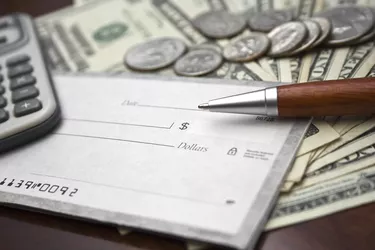
If you accept a check before realizing the check writer hasn't signed it, it isn't as easy to cash it or deposit it into your savings or checking account. Financial institutions are not obligated to accept an unsigned check and may refuse to accept it at all. Other banks and credit unions may still honor it under certain conditions.
How Do I Deposit a Check Without a Signature?
Video of the Day
When you receive a check with a blank signature line, the best thing to do is get in touch with the check writer and ask them to endorse their check or send a new one. But if you need to proceed without a new check, there are a few steps a bank might require.
Video of the Day
- Go to your local bank branch. Don't make a mobile deposit or ATM deposit. Even if your check is accepted, it will likely be returned to you unpaid when the missing signature is noticed.
- Bring a photo ID. Your ID information must match the payee's name on the check.
- Put a restrictive endorsement on the check. The bank may allow you to sign the back of the check with a restrictive endorsement, like "For Deposit Only."
- Guarantee the check. The bank may also require you to add a note in the endorsement area about the lack of signature, such as "Signature Guaranteed," to help prove you are the intended payee of the check.
The Payee Must Guarantee the Check
As the payee and depositor, you must provide a signature guarantee because the bank needs to know that the account holder who wrote the check intended to give it to you. It would be easy for someone to find a blank check and try to deposit it in their own account.
The Uniform Commercial Code (UCC) is a set of laws that govern all commercial transactions in the U.S., including bank transactions and negotiable instruments like checks. According to UCC, the check maker isn't liable for a personal check if they didn't intend for you to have it. And the bank isn't responsible if they've received the payee's guarantee.
The payee's signature and restrictive endorsement tell the bank that the payee is taking responsibility for the check amount. If, during processing, the bank finds out the payee presented a bad check, it can debit the amount back from the payee's account.
When the payer endorses the signature line and the payee endorses the back of the check, the financial institution has proof that both parties intend to make the transaction.
Questions About Unsigned Checks
Some FAQs about unsigned checks include:
Why Didn't the Payer Sign the Check?
It is a simple mistake when a well-intentioned payer forgets to sign a check. It may be as easy to correct as asking for a new check with a signature. But sometimes, a check writer may deliberately send an unsigned check to buy time or resist paying. If you encounter a situation like this, it may be best to ask for a direct deposit transaction or cashier's check next time.
Why Is the Signature Important?
A personal check is just a piece of paper if it's not filled out correctly and properly signed. When the payer endorses the signature line and the payee endorses the back of the check, the financial institution has proof that the paper check is valid and that both parties intend to make the transaction.
When cashing or depositing checks, a blank endorsement or signature line puts that intent in question and puts the bank or credit union and your bank account in danger.
How to Endorse an Unsigned Check
Don't endorse an unsigned check until you arrive at the branch and can be sure of your bank's policy and procedures. Most commonly, the steps will be similar at many banks.
- Sign your name in the endorsement area on the back of the check.
- Add a restrictive endorsement, such as "for deposit only."
- Guarantee the check with a memo such as "signature guaranteed."
- Fill out a deposit slip and deposit your check into your checking or savings account
If all goes well, after the bank teller verifies your identity, the check will be processed and will clear within a few business days.